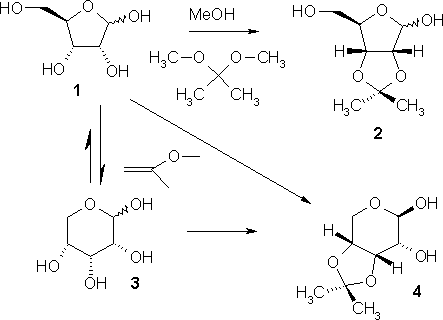Carbohydrate acetalisation
In carbohydrate chemistry carbohydrate acetalisation is an organic reaction and a very effective means of providing a protecting group. The example below depicts the acetalisation reaction of D-ribose 1. With acetone or 2,2-dimethoxypropane as the acetalisation reagent the reaction is under thermodynamic reaction control and results in the pentose 2. The latter reagent in itself is an acetal and therefore the reaction is actually a cross-acetalisation.

Kinetic reaction control results from 2-methoxypropene as the reagent. D-ribose in itself is a hemiacetal and in equilibrium with the pyranose 3. In aqueous solution ribose is 75% pyranose and 25% furanose and a different acetal 4 is formed.
References
- Preparative Carbohydrate Chemistry Calinaud, P.; Gelas, J. in . Hanessian, S. Ed. Marcel Dekker, Inc.: New York, 1997. ISBN 0-8247-9802-3
This article is issued from Wikipedia - version of the 8/29/2014. The text is available under the Creative Commons Attribution/Share Alike but additional terms may apply for the media files.